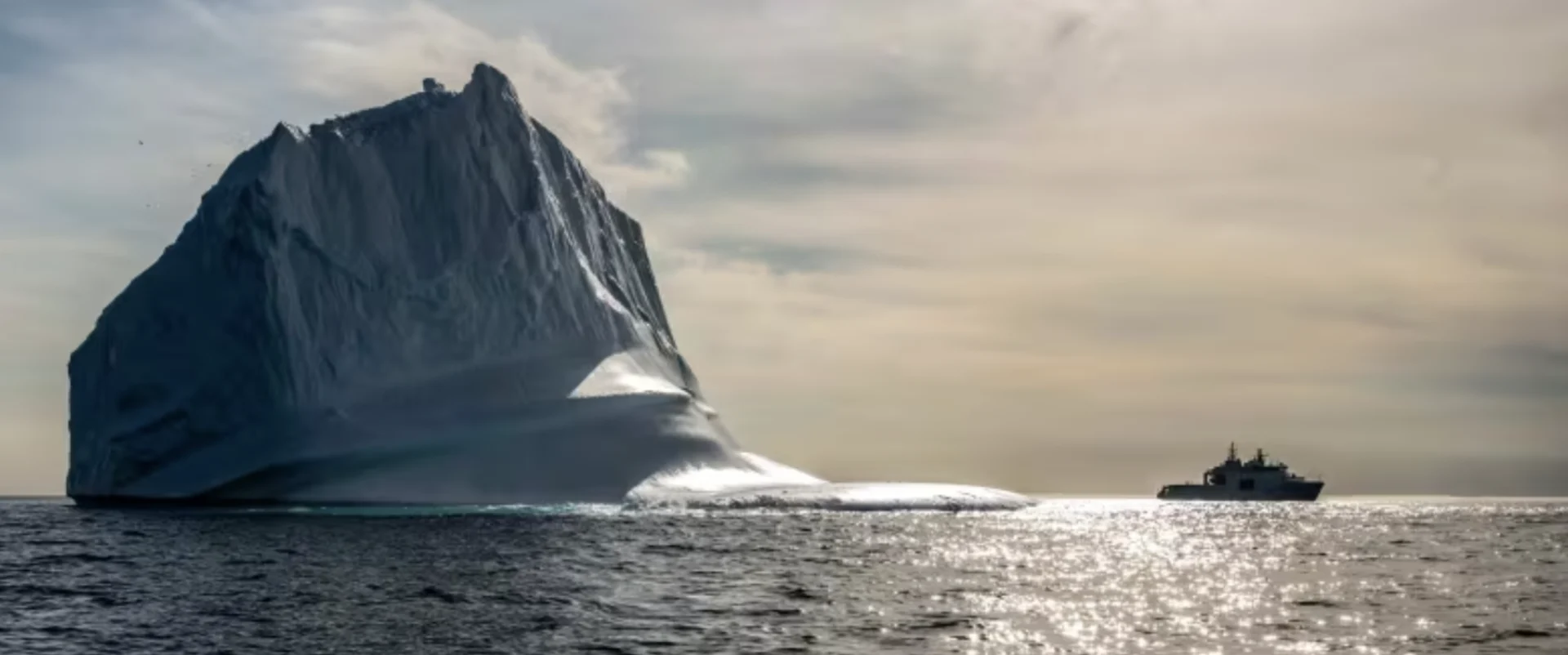
Canadian navy ship spots 25-storey iceberg en route to Arctic training operation

An iceberg — one of the smaller ones seen by the crew — viewed from the deck of HMCS Harry DeWolf as the ship begins the latest Operation Nanook training operation in Canada's Arctic. (Private Brendan Gamache/CAF Imagery Technician)
An iceberg as big as an office tower was spotted this week by the crew of HMCS Harry DeWolf. The ship is sailing north to Operation Nanook, a defence training exercise in the Arctic.
The ship's crew first noticed the iceberg when it was roughly 30 kilometres away.
That's like seeing Citadel Hill from the tarmac of the Halifax Stanfield airport.
"It was so large that there was a small weather system at the tip," said navy Cmdr. Guillaume Côté, commanding officer of HMCS Harry DeWolf. He spoke with CBC News using a satellite connection while the ship passed through the Labrador Sea en route to Iqaluit.
"With all the humidity in the air, the iceberg was so cold that it created its own set of clouds. So it almost looked like the tip of the iceberg was in the clouds," he said. "It was about 25- or 26-storeys tall."
American and French ships join training
The ship's first stop is Iqaluit, but it will also explore other parts of the Arctic region. It will also do training exercises alongside other allied ships.
"We have vessels from the U.S. Navy and the U.S. Coast Guard," said Côté. "We also have a French patrol craft that has the exact mandate that we have."
"From a military standpoint, this [the Canadian Arctic] is not an area of operation that we have very much experience in, except for the last few years," he said.
"This is more for the Canadian Coast Guard, that has been there for the past 60 or 70 years. But for us, it's the presence. We need to see, and we need to be seen. And to be collaborating with all the government partners," said Côté.

HMCS Harry DeWolf will spend the next two months training in the Arctic, and has seen many icebergs so far on its journey. This one is not even the largest spotted by the crew. (Private Brendan Gamache/CAF Imagery Technician)
Crew from across Canada
HMCS Harry DeWolf was delivered to the Royal Canadian Navy in 2020, and was the first ship launched as part of the national shipbuilding strategy.
The ship has participated in Operation Nanook's sovereignty exercises in previous years, and in 2021 it circumnavigated North America — going north around the Arctic, down the West Coast, through the Panama Canal and back up.

HMCS Harry DeWolf sailing between two allied ships. (Private Brendan Gamache/CAF Imagery Technician)
While the ship's captain has experience in far northern regions, this is his first time in the Canadian Arctic.
"I've been north of 60 [degrees latitude] over Europe, and even north of Russia in my younger years. But in the Canadian Arctic this is my first experience. And I have to admit that it's fantastic," said Côté.
"Once you see it for yourself, it's very exciting."
While the ship is based in Halifax, the crew members come from across the country.
"Myself, I'm from Montreal," he said. "A few from the Prairies, which is always surprising that they want to be close to the water and the big ocean.
"And we have two crew members that are actually recent arrivals to Canada."
FROM THE ARCHIVE: Monster iceberg is biggest this Newfoundland town has ever seen (April 2023)
Scientific study also underway
Alongside the military members, there is also space on the ship for scientists.
"We have an Arctic ice expert on board," explained Côté. "So we actually had a chance to close-in on an iceberg, send our small boat, and have the ice expert take some observations and do a little bit of scientific research."

Cmdr. Guillaume Coté, the commanding officer of HMCS Harry DeWolf. (Private Brendan Gamache/CAF Imagery Technician)
According to military officials, Op Nanook is scheduled to last for the next three weeks. The overall deployment will see HMCS Harry DeWolf in the region for approximately two months.
"We're there to collaborate both with national partners and international partners, to be able to actually understand a whole lot better, and be able to operate as a group in the Arctic."
This article, written by Brett Ruskin, was originally published for CBC News.









